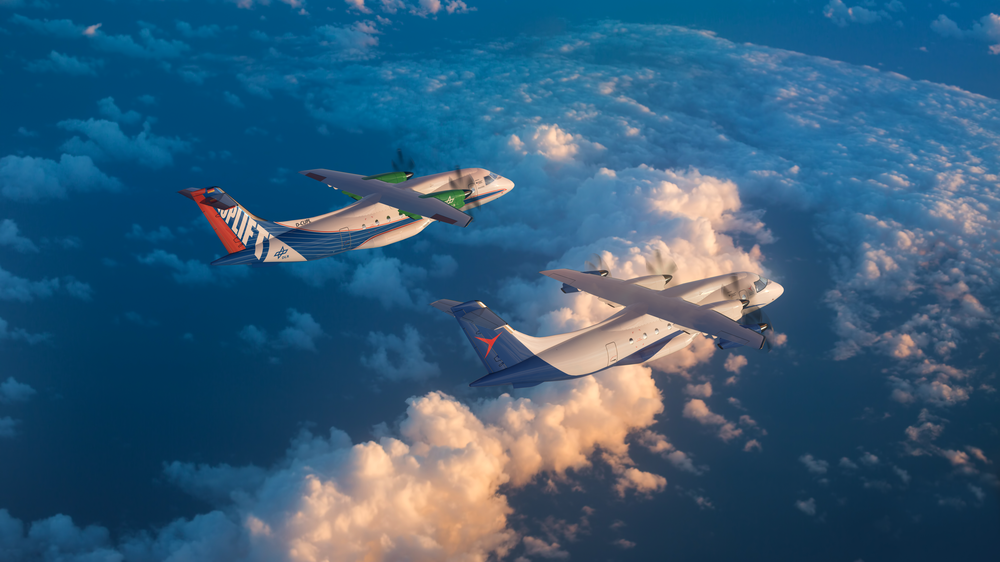Regional aircraft becomes a research laboratory - Deutsche Aircraft
At the former Dornier factory airport in Oberpfaffenhofen, Deutsche Aircraft GmbH has set about not only upholding the legacy of a major aircraft manufacturer, but also actively shaping the future of aviation. "We want to make commercial flights more sustainable and are currently developing our D328eco™, which can fly on up to 100% aromatic-free synthetic fuel in addition to conventional fossil paraffin.
This reduces the CO2 footprint by up to 95%, and the lower soot formation also has advantages for the formation of contrails and local air quality," says Regina Pouzolz, Director Sustainable Flight at Deutsche Aircraft. "As part of the aviation industry, we are committed to working emphatically towards the Net Zero Target." The young company with historical roots is focussing on three pillars:
- Market launch of the new D328eco, a turboprop aircraft for 40 passengers based on the Dornier 328
- Maintenance, care and service of the approximately 150 D328s still in service worldwide
- Research for the aviation of tomorrow

Deutsche Aircraft
The technology network is the quintessence
"Flying more sustainably is not trivial," says Frederic Fischer, Head of the R&T Programme at Deutsche Aircraft. "Of course we have a lot of ideas. We have an engineering team with many experienced and enthusiastic specialists from all over the world," he adds. "But if we don't move closer together in the value chain and work with partners, then we won't achieve our goal." This is why Deutsche Aircraft is cooperating with numerous well-known suppliers such as GE, DIEHL and IABG, with start-ups such as H2Fly and with research institutes such as DLR and Bauhaus Luftfahrt as part of the BMWK-funded aviation research programme. This brings together different competences so that the right technologies can be brought to maturity from this competence network.
But which technologies could these actually be? What alternative drive systems are there? What level of maturity do they have in detail? And which of them could Deutsche Aircraft integrate into its new aircraft programme to enable its customers to fly as CO2-neutrally as possible? These are the key questions that the company wants to answer with the D328 Alpha. "The project is primarily aimed at maturing alternative energy and propulsion concepts to electrify the powertrain," explains Frederic Fischer.
Electrifying research
The teams from Deutsche Aircraft and its project partners are trying to accommodate a tank for liquid hydrogen, a distribution system and the fuel cell in the fuselage of a flying test laboratory. An electric motor will then be mounted on each of the two wings to drive a propeller. The two conventional turboprop engines will also remain on the wings. "This keeps the aircraft within the scope of certification and allows us to test the new systems in relevant environmental conditions in the air," explains Frederic Fischer.
Deutsche Aircraft is currently in the middle of the project. The first wind tunnel campaign was successfully completed last year. The teams analysed a D328 Alpha model with powered propellers in the wind tunnel for nine weeks. He points out that attaching additional propulsion units to the wings of an optimally balanced aircraft would not only affect the weight, but also the aerodynamics and flight physics. That is why the data that can be obtained from such tests is really worth its weight in gold. "We have been able to make all the aerodynamic optimisations that we will now implement one-to-one in our flying research laboratory," he says. At the same time, the teams also worked on the design of the engine nacelles - an in-house development by Deutsche Aircraft, which is significantly lighter and cheaper to manufacture for the electric motors than for conventional gas turbines.
The first steps have been taken
The systems are currently being tested - the electric engine at GE in Prague and the fuel cells on DLR's unique BALIS test rig. But why don't they install the new drive technology in their D328eco straight away? Frederic Fischer says he is often asked this question. And he immediately has the right answer: "We will need the entire volume of the fuselage just for the fuel cell and the hydrogen tank," he says. "There will be no more room for passengers in the aircraft. We only have three seats for two test pilots and a flight test engineer to carry out measurements." However, this is not unusual for technologies that are still in their infancy. Frederic Fischer believes that the first step is to demonstrate the basic feasibility of the technology and then identify starting points that can be used to develop the technology into an economically viable aircraft at a later stage.
Deutsche Aircraft is also working with the DLR on immediately effective technologies and investigating the combustion process of sustainable fuels. The CLIM0ART measurement campaign with the D328® UpLift platform. DLR is cooperating with Deutsche Aircraft and the fuel manufacturer Sasol on the technical realisation. During the measurement campaign, the D328® UpLift aircraft flies in formation with the DLR research aircraft Falcon 20E. This aircraft is equipped with probes for measuring aircraft emissions and analysing the properties of ice crystals in contrails. The measurement campaign is the first to measure the emissions of a CS-25 turboprop aircraft with fully synthetic fuels in flight. The investigations in the air were preceded by extensive ground measurements of the D328® UpLift Flying Testbed turboprop aircraft with synthetic, aromatic-free fuel.
There are also numerous ideas for the consistent further development of regional aircraft: through a stretched wing with reduced air resistance, improved flight controllers and ice protection systems as well as optimised flight routes, which Deutsche Aircraft is investigating as part of LuFo.
Text: Kai Dürfeld
